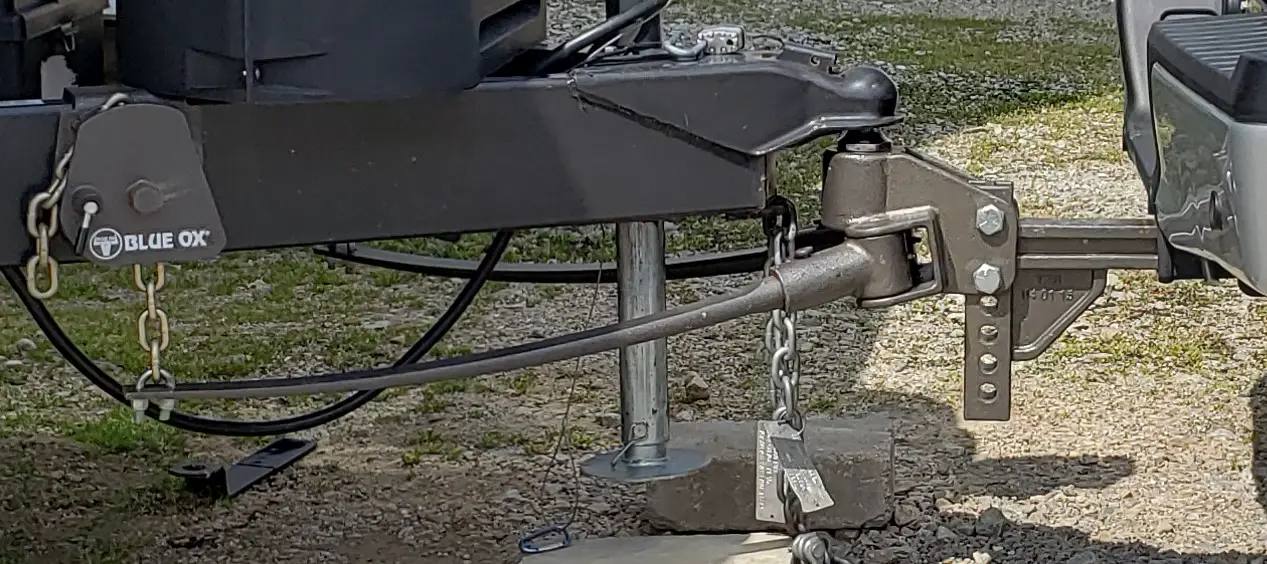A weight distribution hitch helps you distribute weight back to the front axle of your truck. They come in various sizes, and choosing one that fits your needs is essential for efficient use and the proper maintenance of your towing system.
A weight distribution hitch is too big if it is rated too high for the weight of your trailer. You must pick a weight distribution system with a weight range that matches or slightly exceeds the trailer’s tongue weight. This is typically about 10%-15% of the gross trailer weight.
This article explains the adverse effects of using a weight-distribution hitch that is too big. You will also learn how to find the correct weight distribution hitch size and more details to help you use your trailer hitch properly and efficiently.
Don’t forget to check out our Recommended RV Equipment list!
What Happens When a Weight Distribution Hitch is too Big?
You may think that a larger weight distribution hitch performs better, but when you choose one rated too high for the tongue weight of your trailer, you put unnecessary additional weight on your towing vehicle. There are no benefits to using a larger weight distribution hitch, so there is nothing to balance out the risks.
A larger weight distribution hitch affects your vehicle’s maximum hitch capacity and choosing one that is too big limits the weight you can tow.
A weight distribution hitch already puts more pressure on trailer tires, depending on how tight or stiff you make your trailer connection. A larger weight distribution hitch can overload the trailer’s gross axle weight (GAW). If you do not adequately adjust your speed, heat buildup will cause them to blow down the road.
It can also lead to a less pleasant drive. While using an inadequate hitch can lead to squatting, a weight-distribution hitch that is too big will cause a stiff and harsh ride.
It’s best to avoid these issues by finding a weight-distribution hitch adequately sized for your vehicle and trailer. Not only will this save you money, but it will also lead to an easier ride and prevent some significant issues.
Finding the Right Weight Distribution Hitch Size
Before you choose a weight-distribution hitch, you need to know your Gross Trailer Weight and the Gross Tongue Weight of the trailer.
The Gross Trailer Weight is usually located on a sticker on the trailer. This lets you know how heavy your trailer is while empty. You can also calculate the Gross Trailer Weight by pulling the trailer across a vehicle scale. You should also pay attention to maximum ratings to future-proof your setup.
Your Tongue Weight typically sits between 10 and 15 percent of the total weight of your trailer, but it can change depending on the trailer’s design and how you load it.
Calculating tongue weight using this range makes finding a weight-distribution hitch easier. If you have a trailer with a GTW of 4000 lbs, the tongue weight sits between 400 and 700 lbs.
Your weight distribution hitch rating must match or slightly exceed your Gross Trailer Weight. It should sit at or near the top of your tongue weight range.
Using the example above, you could find a weight-distribution hitch rated for a 5000 lbs total trailer weight and 700 lbs of tongue weight.
Other Considerations When Choosing a Weight Distribution Hitch
- If you plan to install your weight distribution hitch yourself, choose a model that is easy to install or matches your capabilities. You can save money on installation, but there is no point if you can’t figure out how to do it.
- Consider whether you need to switch the hitch between different vehicles. Not all models change tow vehicles easily.
- Expect to budget anywhere from $200 to $2,000 for a weight-distribution hitch. The sweet spot is between $400 and $800 for a decent setup, including installation. I personally recommend a Blue Ox weight-distribution hitch.
- Weight distribution hitches with sway control built-in require special considerations. Look into whether you’ll need to manually adjust for different camper weights or if the WDH will self-adjust.
- A weight distribution hitch with friction sway control bars requires you to get out and unhook them before reversing. Other styles, including 2-point, 4-point, and chain styles, do not need you to disassemble before backing up.
- You must select a ball mount with the appropriate drop to keep your trailer level while being towed.
- Round spring bar hitches offer lower upfront costs but have the lowest ground clearance.
- The system weight must be deducted from the maximum hitch capacity of your vehicle. The biggest weight distribution hitch is not always the best investment.
More About Weight Distribution Hitches
Weight distribution hitches, also known as load-leveling hitches or equalization hitches, work to prevent issues that arise when you’re towing a heavier load or notice an imbalance in the spread of weight across your axles.
They used adjustable spring bars and tension to level everything out, distributing the excess tongue weight between your towing vehicle’s front and rear axles.
Doing this allows you to drive your vehicle more easily while towing a heavier load. This does not increase your payload capacity but ensures you can get the most out of your towing package.
The weight distribution hitch will not compensate for other issues, such as an imbalance load, but most hitches on the market do their job well. The rest is up to you.
Weight Carrying Hitch VS Weight Distribution Hitch
A weight-carrying hitch is your typical connection using a trailer ball on a simple mount arm. This type of hitch creates an accessible pivot point, and the tongue weight of the trailer on the hitch causes the front to lift.
A weight distribution hitch creates a binding connection. Instead of allowing a freely rotating pivot, the weight distribution hitch creates a semi-locked bridge that overlaps and creates a more secure connection that does not bend or rotate. By locking the coupling into alignment, there is no freedom of motion.
What Happens When You Use a Weight Distribution Hitch
Without the weight distribution hitch, a trailer causes your tow vehicle’s front end to lift. The weight also forces the rear axles to squat down, hence the term “squatting hitch.”
The front axles lose weight in this situation, so downward pressure is needed for proper performance. This reduces the vehicle’s ability to brake and handle well, so you are more prone to oversteering when cornering the vehicle. It also increases the risk of swaying or fishtailing.
Your rear axles take on the weight, which can strain the rear axles and overload your payload capacity. A major issue here is wear on the tires, similar to what occurs when you use a weight-distribution hitch that is too big.
When you incorporate a weight-distribution hitch, it evens out the weight across both axles, restoring some to the front and alleviating stress on the rear.
While this does not decrease tongue weight, it ensures everything is properly distributed, so you do not run into issues while handling your towing vehicle.
Do You Need a Weight Distribution Hitch?
You need a weight-distribution hitch if you notice any signs of improper weight distribution. The most noticeable include:
- Difficulty steering
- Difficulty stopping
- Trailer sagging
- Increased sway
Trailers at 50 percent of capacity usually benefit from using a weight distribution trailer and any loaded trailers over 5000 lbs or short wheelbase trucks and SUVs.
Almost all pickup truck and SUV manufacturers require you to use a weight-distribution hitch if you tow over a certain amount.
| Vehicle Make | Maximum Load Without WDH |
|---|---|
| Ford | 5000 |
| Nissan | 5000 |
| Dodge | 5000 |
| Toyota | 5000 |
| GMC | 7000 |
This requirement is subject to change and may vary depending on your vehicle model. Your vehicle’s owner’s manual should provide you with any specifications regarding weight distribution. You usually see this warning as “weight distribution and sway controls over x lbs.”
It is essential to use a weight-distribution hitch of the proper rating to unlock the full potential of your vehicle.
The Bottom Line
Just as you can purchase a weight-distribution hitch that is too small, it is possible to end up with one that is too big. This can cause several issues in other areas, potentially canceling the benefits of using a weight weight-distribution
Take the time to check your towing vehicle requirements and evaluate the towing performance. This indicates when you must incorporate a weight-distribution hitch in your towing setup.
When it comes time to add a weight-distribution hitch, choose one with an appropriate rating. This ensures you will not have issues in either direction, keeping you and everyone on the road safe and secure.
Don’t forget to check out our Recommended RV Equipment list!
Get a FREE copy of the Go Together Go Far Travel Trailer Hookup and Disconnect Checklist when you sign up for the Go Together Go Far Newsletter!
Want to learn more about different types of RVs? Check out:
- Best Off-Road Camper Trailer Under $10,000
- Best Bunkhouse Travel Trailer Under 30 Feet
- Are Lance Travel Trailers Any Good?
- Do Rope Lights Deter Rodents?
- What Are the Best Names in the RV Industry?
- 3 Best Travel Trailers for Family of Four
- Blue Ox SwayPro Basics: Top Questions Answered
- Adding A Washer Dryer To Travel Trailer? What You Need To Know.
- Best Drone For Camping, Backpacking, and RVing: A Complete Guide to Drones for RVers
- Furniture and RVs – How To Get It Through the Door…
- How To Get Rid Of A Poop Pyramid In RV Black Tank
- Do You Know How Long To Keep Fresh Water In RV Tank Storage?
- What Is The Best Outdoor Security Camera System For Your RV?
- RV Bumper Mount Grills: 5 Best Options For Your RV Or Camper
- Best Electric Tankless Water Heater for Your RV. What You Need To Know
- Read Before You Buy! How to Find the Best Scooter for RV Camping
- 3 Best Travel Trailers for Family of Four
- Top RV Brands: What Are the Best Names in the RV Industry?
- Lance Campers: What Makes Them So Different?
- Best Bunkhouse Travel Trailer Under 30 Feet
- Best Off-Road Camper Trailer Under $10,000
- Best Weight Distribution Hitch With Sway Control For Travel Trailers in 2022
- What Are The Best Built Travel Trailers? Things To Consider.
- How Does An RV Refrigerator Work? A Quick Guide.
- Why Does My RV Carbon Monoxide Detector Keep Beeping? A Quick Guide.
- Where Is The Power Converter In My RV Or Travel Trailer
- What is the Best Generator for 50 Amp RV?
- Wireless RV Security Camera Systems: Is Solar Powered Security Without Wi-Fi An Option?
- Best Portable Air Conditioner for Camping for 2022
- How to Find the Best 3500 Watt Inverter Generator for RV Camping
- Best Propane Generator For Your RV: Read This Before You Buy!

